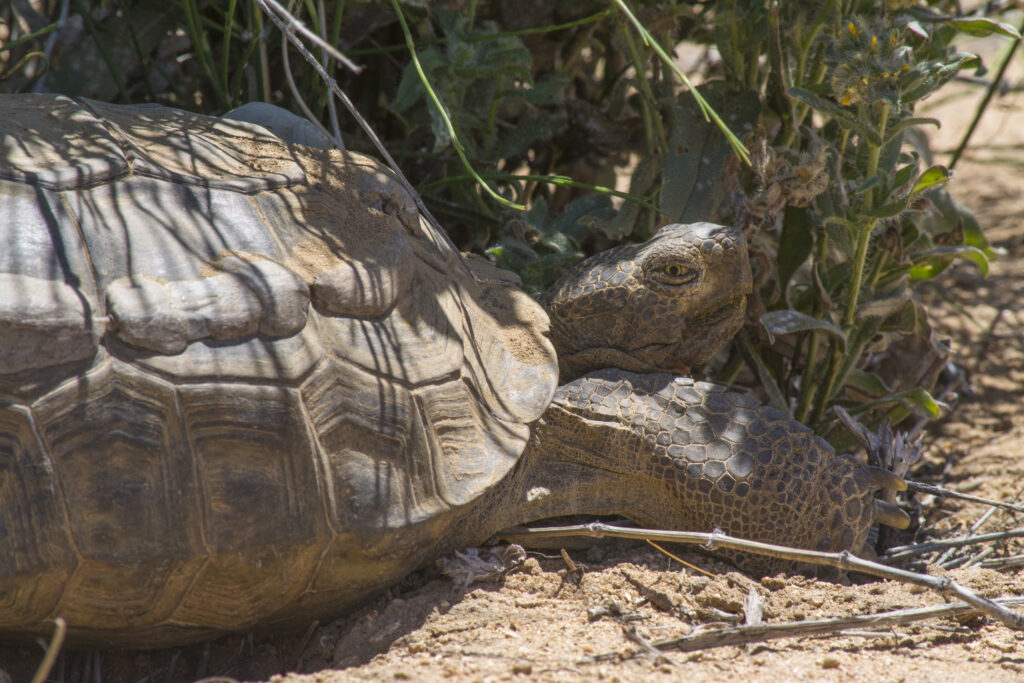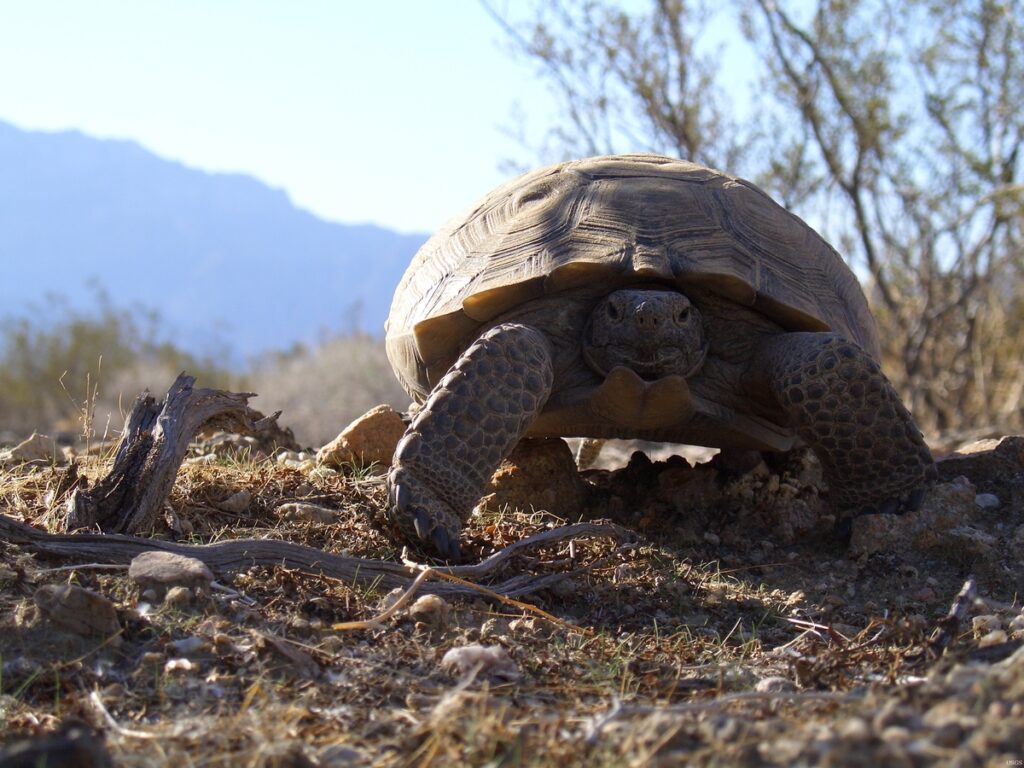
If you look closely at the shell, you’ll see some abnormalities. This tortoise has a transmitter glued to his shell and is part of a long-term research project for Joshua Tree National Park. Because of his transmitter, park biologists can find him every year and assess his health. Original public domain image from Flickr
Clark County Celebrates Desert Tortoise Week
This week, agencies across the Mojave Desert celebrated Desert Tortoise Week. This remarkable animal has become a keystone species for wildlife conservation and a conversation starter for exploring the Mojave Desert.
A Loveable Face

Slow, steady, and serene, the desert tortoise is Clark County’s most well-known reptile, a favorite with kids and adults alike. They are found across the Southwest in Nevada, Arizona, Utah, and California. But what makes them so loveable?
Perhaps it’s their wise-looking face, all wrinkled and scaly, which helps protect them from all the digging they do as they burrow into the ground for shelter. Maybe it’s the way they gently amble along desert washes, traveling long distances in search of food like grasses, desert willow flowers, and prickly pear cacti. Or maybe it’s the fact that they’re a keystone species, and protecting them creates a ripple effect on the whole desert ecosystem. For example, many other species, such as Gila monsters, roadrunners, and burrowing owls, use old tortoises burrows as new homes.
Threats to the Desert Tortoise
In the wild, desert tortoises live anywhere between 30-50 years. Although, they must be wary of predators like ravens, kit foxes, coyotes, and more. But on top of predation threats, desert tortoises face many other challenges today. In 1990, the desert tortoise was listed as threatened under the Endangered Species Act after development in Clark County put desert tortoise habitat at risk.
Development continues to be a significant challenge in desert tortoise conservation, from outright habitat loss to fragmentation, where tortoises cannot travel between areas to forage for food or find a mate. Another major threat to the desert tortoise is the ongoing drought. Although adapted for periods of drought and can hold 40% of their body weight in their bladder, prolonged drought affects the plants they forage for. They need a wide variety of grasses, shrubs, flowers, cacti, and succulents to eat and get most of their water from these plant sources.
Some ways to mitigate the effects of the drought and habitat loss include advocating for public lands and keeping development, such as housing and renewable energy, off of areas with a high desert tortoise population. Another way to support desert tortoises is to support organizations that advocate for them. Because they’re protected under the Endangered Species Act, many agencies collaborate to conserve and monitor desert tortoise populations. Find more information about ongoing efforts at the U.S Fish & Wildlife Service, National Fish and Wildlife Foundation, the Nature Conservancy, and the Desert Tortoise Council pages.
Desert Tortoises in Clark County
Did you know that the desert tortoise has shaped the development of Clark County?
In 1989, the desert tortoise was emergency listed under the Endangered Species Act because of concern over Clark County’s development taking away their habitat. By 1990, when the desert tortoise was formally listed as threatened under the Endangered Species Act, Clark County formed the Desert Conservation Program (DCP). This worked to better manage habitat for the desert tortoise, working with a diverse set of organizations like government representatives, private landowners, public lands managers, biologists, and others.
Today, the DCP supports desert tortoises by conducting research, restoring habitat, public outreach, and more. For example, they train construction crews about the protocol if they find a desert tortoise on a development. And they run a hotline for construction sites that find a desert tortoise. If one is found, it is translocated to a protected habitat in the Boulder City Conservation Easement, an 87,268 property where desert tortoises are protected to mitigate the impact of construction within the Las Vegas Valley.
(Article continues after the ad)
Please follow our fantastic site sponsors! They make content like this possible! 🙂
A Local Celebrity: Mojave Max
Mojave Max is crucial to the DCP’s desert tortoise outreach program. As the official mascot, he has an essential job: teaching the community about desert tortoises, conservation, and how to explore the Mojave Desert safely.
Mojave Max lives at the Springs Preserve and is the star of the annual Mojave Max Emergence Contest, where students in grades K-5 can predict when he’ll emerge from his burrow in the springtime and win prizes if they predict the correct date. Desert tortoises hibernate in late September- October when temperatures get cold but emerge again when temperatures are warm. Mojave Max greeted his fans this year after a long hibernation on April 24.
As a mascot, Mojave Max visits schools throughout the year and is part of a partnership between the DCP and Get Outdoors Nevada. By inspiring students to protect the Mojave Desert, Mojave Max supports his wild tortoise counterparts and fosters a love for the many wonders of the desert. The Mojave Max website also has various resources, such as books and activity sheets, that parents and teachers can use to teach children about the desert.
#GetinMotion to Support Desert Tortoise Week
To celebrate Desert Tortoise Week and learn more about the Mojave Desert, there are several things you can do!
Learn More in the City
Visit the Springs Preserve, which hosts activities like tortoise crafts and toddler storytime. It’s also a great place to learn more about the Mojave Desert without leaving the city.
Head out of Town
If you want to travel, Joshua Tree National Park is hosting a “tortoise table” at their visitor center to learn more about the icon of the park.
Visit a Local Preserve
To see a live desert tortoise, visit the Springs Preserve or the Henderson Bird Viewing Preserve. You can also explore wild places like Red Rock Canyon, the Boulder City Conservation Easement, and other desert trails. Remember to explore responsibly by picking up your trash, staying on designated trails, and keeping dogs on leashes.

Help Keep Their Habitats Clean and Safe!
If you happen to find a desert tortoise in the city (or anywhere), the best practice is to leave it alone. If it’s in the middle of a busy road, then move it carefully to the direction it was heading and place it in the shade if possible. When picking up a tortoise, there is a risk that it will urinate and empty all the contents of its bladder. Losing all the water it was storing can prove deadly for these animals trying to survive the dry and hot Mojave Desert. That’s why leaving wild tortoises alone is the best thing to do. If you’re concerned that the tortoise is a lost pet, such as if it approaches you for food, refer to the Tortoise Groups’ Lost and Found Page. Visit the Nevada Department of Wildlife page for more information.
Lastly, check out a previous MiM Mag article on the local organization, Desert Balloon Project. Christian Daniels, who founded DBP in 2020, made it his mission to pick up Mylar balloons in the desert and educate the public on how releasing balloons is potentially harmful to desert tortoises and other wildlife.
Thank you to our supporters and sponsors!
As always, we want to thank our Patreon’ Cultivator’ supporters and sponsors who help make content like this possible.
The following Patron(s) supported the production of this article:
Crystal Gropp
The following sponsors supported the production of this article:
Viva La Compost & LunaKai Lash




